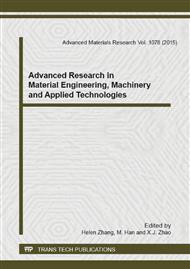[1]
Hailan Gu, Wei Zhang. Solving Queuing Theory model Problem with Matlab [J]. Hebei Enteprise. 2011(4).
Google Scholar
[2]
Chuanyi luo, Yinghui Tang, WeiLi, Kaili Xiang. The resursive solution of queue length for Geo/G/1 queue with N-policy[J]. Journal of system Science and Complexity. (2012).
Google Scholar
[3]
Shuliang Zheng. Queueing models Based Performance Evaluation Approach for Video On Demand Back Office System[A]. The 9th International Symposium on Operations Research and Its Applications in Engineering, Industry and Management. (2010).
DOI: 10.1109/icsess.2010.5552438
Google Scholar
[4]
Aobing Sun. Tongkai Ji, Qiang Yue, Song Yang. IaaS Public Cloud Computing Platform Scheduling Model and Optimization Analyzation[A]. 2010 Third International Conference of Education Technology and Training(ETT2010). (2010).
DOI: 10.1109/anthology.2013.6785011
Google Scholar
[5]
Jinde Lin,Liu Houming. Jisuanji Wangluo Daquan:Electric Industry Press,1997,187-195.
Google Scholar
[6]
Xuansen He. The Theory of random process and queuing[M]. HuNan:Hunan University Press. 2010:165-165.
Google Scholar
[7]
SusanA. Shaheen, Matthew Barth. The potential for shared-use vehicle system in China [J]. (2006).
Google Scholar
[8]
Minli Ren. Research on Application of Queuing Theory in Modern Bank service[D]. Harbin:Harbin Institute of Technology. 2009.
Google Scholar
[9]
Zhiwei Ni. Modeling and Simulation of Order Processing System based on Queuing Theory[D]. Beijing:Beijing Jiaotong University/(2009).
Google Scholar
[10]
Shipeng Li. An Optimization Design Approach of Car-Sharing Based on Queuing Theory:[D]. Hangzhou:Electric Science and Technology University,(2012).
Google Scholar
[11]
Wenxia Liu. Method of Demond Analysis and Equipment Optimization in Electric Vehicle Fast Charging Station[J]. Journal of Tianjin University. 0493-2137-(2012)12-1110-06.
Google Scholar


